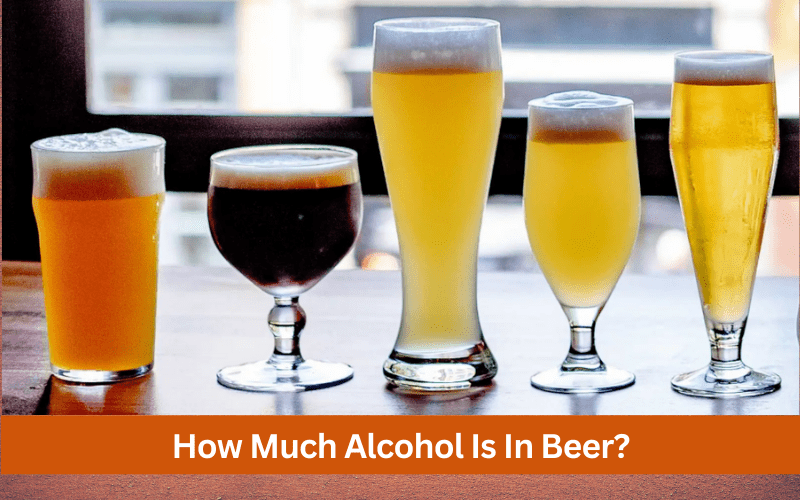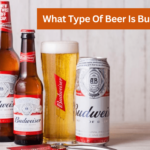Ah, beer. The drink of choice for many, especially during a hot summer day. You grab a cold one, pop the cap, and take a swig. But have you ever wondered how much alcohol is in beer? As a beer lover myself, I know how easy it is to get lost in the enjoyment of a great brew without giving much thought to its alcohol content. However, as I have grown older and more conscious of my health and wellness, I began to wonder about the amount of alcohol I was consuming in each beer. In this article, we will explore the topic of how much alcohol is in beer and how understanding this can impact your health and enjoyment of the drink.
What is Alcohol?
Alcohol, also known as ethanol, is a chemical compound that is produced by the fermentation of sugars and other carbohydrates by yeast or other microorganisms. It is a psychoactive substance that has sedative, anxiolytic, and euphoric effects when consumed in moderate amounts, but can be highly addictive and harmful in excessive amounts.
What is Beer?
Beer is an alcoholic beverage made from water, malted grains (usually barley), hops, and yeast. The grains are first soaked in hot water to release their sugars, which are then fermented by yeast to produce alcohol and carbon dioxide. Hops are added to provide flavor and balance the sweetness of the malt, while also acting as a natural preservative. There are many different types of beer, each with their own unique flavor and characteristics.
The Different Types of Beer
There are many different types of beer, each with their own unique flavor and characteristics. Here are some of the most common types of beer:
- Lager: Lager is a type of beer that is fermented and aged at low temperatures. It is characterized by its light, crisp flavor and pale color.
- Ale: Ale is a type of beer that is fermented at warmer temperatures than lager. It is typically darker and more full-bodied than lager, with a fruity or spicy flavor.
- Stout: Stout is a dark, rich beer that is made using roasted barley. It has a creamy, smooth texture and a slightly bitter taste.
- Porter: Porter is a dark, malty beer that is similar to stout but typically lighter in body and alcohol content.
- Wheat beer: Wheat beer is made using a high proportion of wheat in the grain bill. It is often unfiltered, which gives it a hazy appearance, and has a light, refreshing taste.
- Pilsner: Pilsner is a type of lager that originated in the Czech Republic. It is characterized by its light color, crisp flavor, and distinctive hop aroma.
- Belgian beer: Belgian beer is a broad category that includes a wide range of beer styles, from light and fruity to dark and complex. Belgian beers are often highly carbonated and have a distinctive spicy or fruity flavor.
- IPA: IPA (India Pale Ale) is a type of beer that is characterized by its strong hop flavor and high alcohol content. It is often brewed using American or English hops, and can be either pale or dark in color.
- Sour beer: Sour beer is a type of beer that is brewed using wild yeasts or bacteria, which give it a tart, acidic flavor. Sour beers can be light or dark in color, and can range from mildly tart to intensely sour.
- Fruit beer: Fruit beer is a type of beer that is brewed using fruit or fruit juice, which gives it a sweet, fruity flavor. Fruit beers can be light or dark in color, and can range from mildly fruity to intensely sweet.
These are just a few of the many types of beer that are available. Each type of beer has its own unique flavor and characteristics, making it a versatile and enjoyable beverage for many occasions.
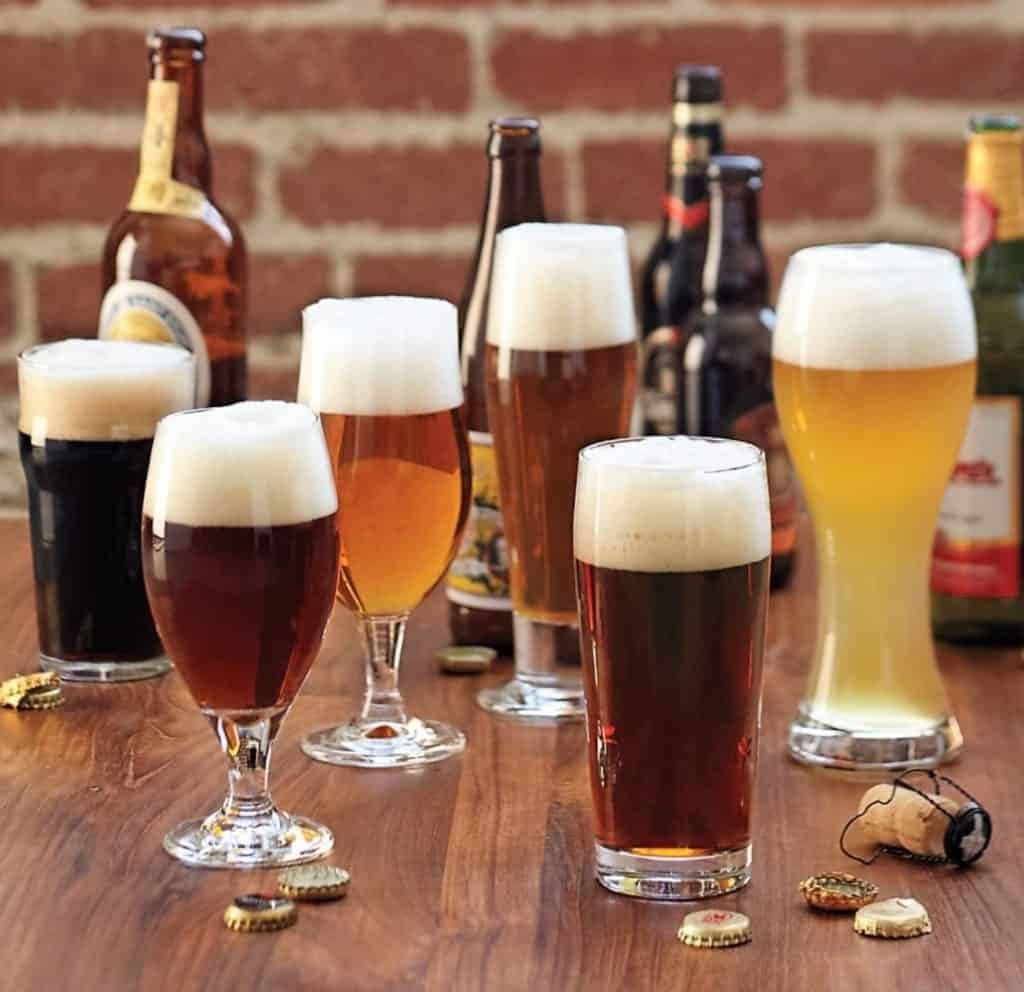
Does Beer Have Alcohol Percentage?
Yes, beer does have alcohol percentage. The amount of alcohol in beer is usually measured as a percentage of alcohol by volume (ABV). This percentage can vary depending on the type of beer, the brewing process, and other factors.
It’s important to be aware of the alcohol content in beer, as consuming too much alcohol can lead to a range of negative health effects.
How Much Alcohol is in a Beer?
Do you know how much alcohol is in beer? The amount of alcohol in a beer can or beer bottle, as well as in a 12 oz beer, can vary depending on the type of beer and the brewing process. In general, most beers range from 2-13% alcohol by volume (ABV), with some specialty beers exceeding 20% ABV.
A typical 12-ounce serving of beer with an ABV of 5% contains about 0.6 ounces of pure alcohol.
However, it’s important to check the label or ask the brewer or bartender for the specific alcohol content of a beer to know exactly how much alcohol it contains.
Is 5% alcohol a lot?
In general, 5% alcohol is considered a moderate amount and is similar to the alcohol content of most regular beers. However, drinking too much of any alcohol can lead to negative health effects, impaired judgment, and the risk of accidents or injuries.
Is 8% alcohol a lot?
8% alcohol is considered relatively high for a beer and may have a stronger effect on the body and brain than a beer with a lower alcohol content. Be aware of the alcohol content of any drink you consume and to drink in moderation to reduce the risk of negative health effects.
Categories of Beer Based on Alcohol Content
Beers can be broadly categorized into three main categories based on their alcohol content:
Low-alcohol beer
Low-alcohol beers, also known as light beers, typically contain 0.5-3% ABV. These beers are often marketed towards health-conscious consumers or those who want to enjoy a beer without getting too drunk.
Standard beer
Standard beers typically contain 4-6% ABV, although the range can be wider depending on the specific beer style. This category includes the majority of beers that are commonly consumed worldwide.
Strong beer
Strong beers, also known as high-gravity beers, typically contain 7% ABV or higher. These beers are often brewed using more malt or sugar to increase their alcohol content and can have more complex flavors and aromas. Some strong beers can have alcohol contents as high as 20% ABV or more.
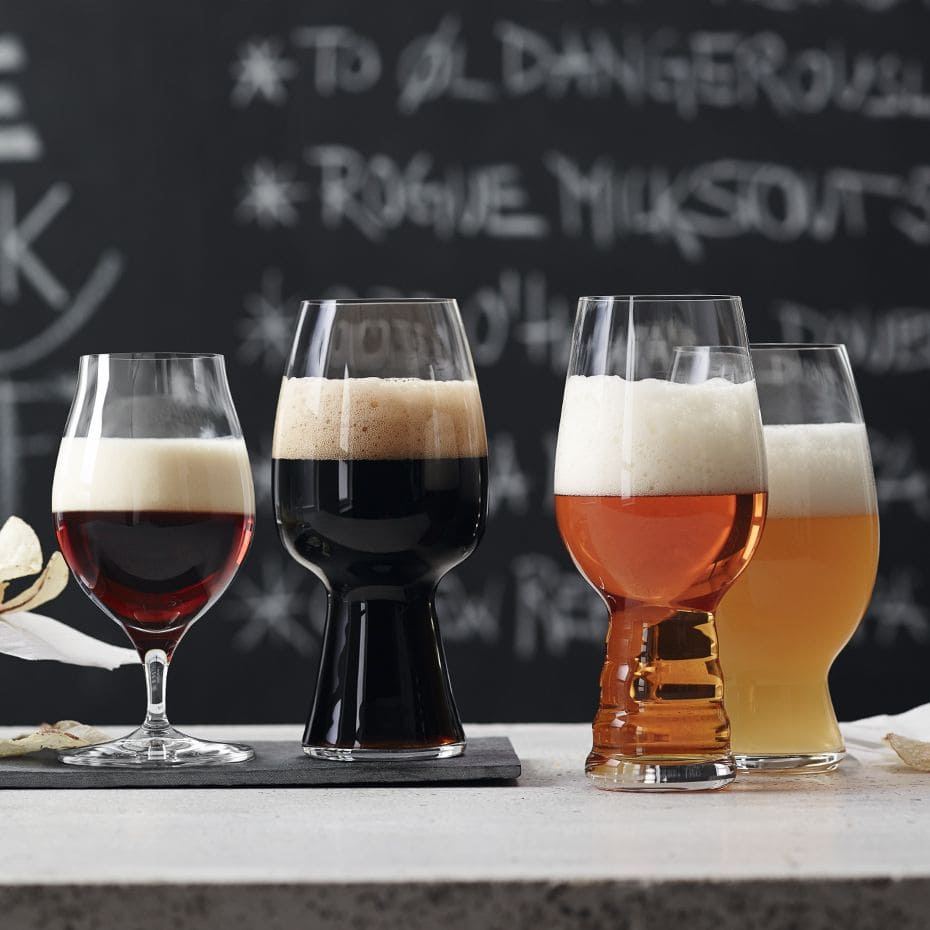
How Much Alcohol is in Beer: Different Beer Style
How much alcohol is in beer can vary depending on the style and brewing process. Here is a rough range of alcohol content for some common beer styles:
- Pale lagers and pilsners: 4-5% ABV
- Amber and dark lagers: 4-5.5% ABV
- Wheat beers: 4-6% ABV
- Belgian ales: 6-9% ABV
- India Pale Ales (IPAs): 6-7.5% ABV
- Brown ales: 4-6% ABV
- Porters: 4-6% ABV
- Stouts: 4-7% ABV
- Barleywines: 8-12% ABV
How Much Alcohol is in Beer: Famous Brands
| Beer Brand | Alcohol Content (ABV) |
| Miller64 | 2.8% |
| Modelo Chelada | 3.5% |
| Coors Light | 4.2% |
| Corona Extra | 4.6% |
| Guinness Draught | 4.2% |
| Michelob Ultra | 4.2% |
| Miller Lite | 4.2% |
| Pabst Blue Ribbon | 4.8% |
| Budweiser | 5% |
| Heineken | 5% |
| Sierra Nevada Pale Ale | 5.6% |
| Stella Artois | 4.6% – 5.2% |
| King Cobra | 5.9% |
| Campfire King | 7.4% |
| Captain’s Daughter | 8.5% |
| Stone Brewing | 9.4% |
| Chimay | 9% |
| Key Bump | 10.5% |
| Good Night Moon | 11% |
| Greylock | 12% |
How Much Alcohol is in Beer Vs Wine Vs Spirit
Beer, wine, and spirits can vary in alcohol content. Here are some rough comparisons:
- Beer generally has a lower alcohol content compared to wine and spirits. The alcohol content in beer typically ranges from 3-13% ABV, with most beers falling in the 4-6% range.
- Wine usually has a higher alcohol content than beer. The alcohol content in wine can range from 5-23% ABV, with most wines falling in the 12-15% range.
- Spirits, such as whiskey, vodka, gin, and rum, have a higher alcohol content compared to beer and wine. The alcohol content in spirits typically ranges from 20-60% ABV, with most spirits falling in the 40-50% range.
Factors Affecting Alcohol Content in Beer
There are several factors that can affect the alcohol content in beer, including:
- Ingredients: The type and amount of malt, hops, and other ingredients used in the brewing process can affect the alcohol content in beer.
- Yeast strain: Different strains of yeast can have varying levels of alcohol tolerance, which can affect the final alcohol content in beer.
- Fermentation temperature: The temperature at which the beer is fermented can affect the activity of the yeast and the rate of alcohol production.
- Length of fermentation: The length of time that the beer is fermented can also affect the alcohol content. Longer fermentation times generally result in higher alcohol content.
- Water chemistry: The mineral content of the water used in brewing can affect the pH level of the beer, which can impact the activity of the yeast and the final alcohol content.
- Carbonation: Carbonation can affect the perceived alcohol content in beer. Higher levels of carbonation can make beer taste stronger and more alcoholic.
Brewers carefully control these factors to achieve the desired alcohol content and flavor profile in their beers. However, natural variations can occur, and the alcohol content in beer can vary depending on the specific beer style and brewing process.
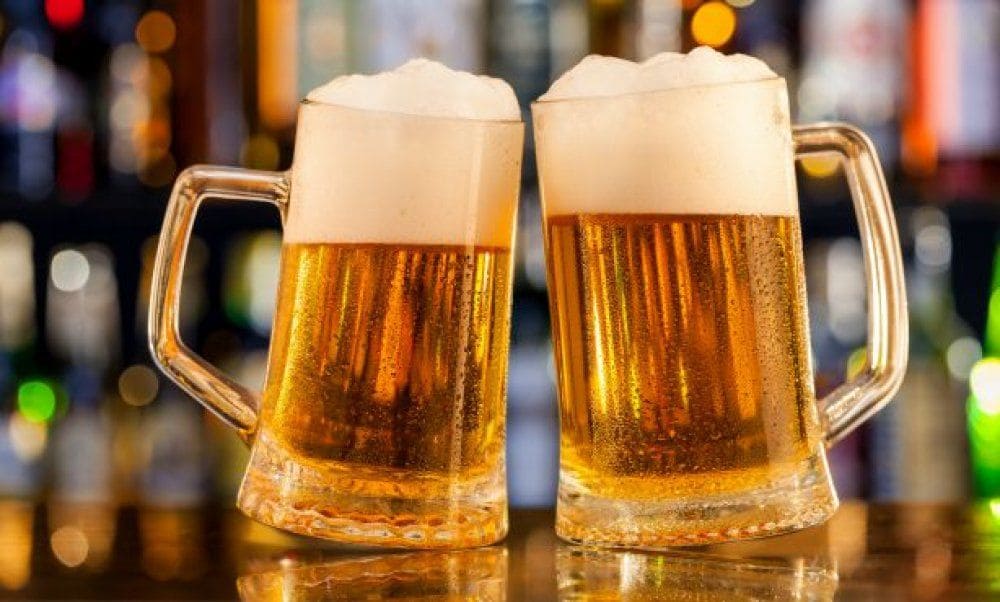
The Effects of Alcohol in Beer
Alcohol in beer can have a range of effects on the body and mind. Here are some of the most common effects:
- Relaxation: Alcohol in beer can have a sedative effect on the body, which can lead to feelings of relaxation and reduced stress.
- Impaired judgment: Consuming alcohol in beer can impair judgment, reaction time, and coordination, which can increase the risk of accidents, injuries, and poor decision-making.
- Dehydration: Alcohol in beer is a diuretic, which means it can increase the amount of urine produced by the body and lead to dehydration.
- Hangover: Consuming too much alcohol in beer can lead to a hangover, which can include symptoms such as headache, nausea, fatigue, and sensitivity to light and sound.
- Addiction: Alcohol in beer is a highly addictive substance, and consuming large amounts of beer or drinking beer frequently can lead to dependence and addiction.
- Negative health effects: Consuming too much alcohol in beer can lead to a range of negative health effects, including liver damage, high blood pressure, increased risk of cancer, and mental health problems.
Why Knowing Alcohol Content in Beer is Important?
Knowing the alcohol content in beer is important for several reasons:
- Responsible drinking: Being aware of the alcohol content in beer can help you drink responsibly and avoid overconsumption or getting drunk too quickly.
- Health effects: Consuming too much alcohol can have negative health effects, such as liver damage, high blood pressure, and increased risk of cancer. Knowing the alcohol content in beer can help you make informed decisions about your alcohol consumption and reduce the risk of negative health outcomes.
- Flavor and taste: Different types of beer have different alcohol contents, which can affect their flavor and taste. Understanding the alcohol content of a beer can help you choose a beer that fits your taste preferences.
- Compliance: The alcohol content of beer is regulated in many countries, and knowing the alcohol content can help ensure compliance with local laws and regulations.
- Comparing beers: Knowing the alcohol content in beer can help you compare different types and brands of beer, and make informed decisions about which beers to try or purchase.
Overall, understanding the alcohol content in beer can help promote responsible drinking, protect your health, and enhance your enjoyment of beer.
How to Reduce Alcohol Content in Beer?
Reducing the alcohol content in beer can be a challenging process, as the alcohol is a natural byproduct of the fermentation process. However, there are a few methods that can be used to reduce the alcohol content in beer:
- Dilution: Diluting the beer with water or a non-alcoholic beverage can lower the alcohol content. However, this method can also affect the flavor and mouthfeel of the beer.
- Reverse osmosis: Reverse osmosis is a process that can remove alcohol from beer by forcing it through a semi-permeable membrane. This method can be expensive and time-consuming, and can also affect the flavor and quality of the beer.
- Fermentation control: Controlling the temperature and duration of the fermentation process can affect the alcohol content in beer. Lower fermentation temperatures and shorter fermentation times can result in lower alcohol content.
Alcohol-Free Beer
Alcohol-free beer, also known as non-alcoholic beer, is a type of beer that is brewed to contain very low levels of alcohol or no alcohol at all. In the United States, alcohol-free beer is defined as beer that contains less than 0.5% ABV.
Does 0 0 beer contain alcohol?
In most countries, 0.0 beer is defined as non-alcoholic beer, meaning that it contains less than 0.5% ABV (alcohol by volume). This is because alcohol is a natural byproduct of the brewing process, and it is difficult to completely eliminate it from beer.
However, non-alcoholic beers are brewed to contain very low levels of alcohol, typically less than 0.5% ABV, which is significantly lower than the alcohol content in traditional beers.
Types of alcohol-free beer
There are several types of alcohol-free or non-alcoholic beer available in the market today. Some of the most common types include:
- Low-alcohol beer: These beers contain less than 0.5% ABV and are often marketed as non-alcoholic or alcohol-free beers.
- Alcohol-free beer: These beers contain no alcohol at all, with an alcohol content of 0.0% ABV.
- Light beer: Light beers are typically low in calories and alcohol content, with an ABV ranging from 2-4%.
- Flavored beer: Flavored non-alcoholic beers are brewed to mimic the taste of traditional beers, with added flavors such as fruit, spices, or herbs.
- Craft non-alcoholic beer: Craft brewers have started producing non-alcoholic beer, with a focus on unique and complex flavor profiles.
- Gluten-free beer: Gluten-free non-alcoholic beer is brewed with grains such as rice, sorghum, or millet instead of barley or wheat, making it a good option for people with gluten sensitivities or celiac disease.
Brand of alcohol-free beer
There are many different types of non-alcoholic or alcohol-free beer to choose from. Some well-known brands of alcohol-free beer are as follows:
- Heineken 0.0
- Budweiser Prohibition Brew
- Beck’s Blue
- Clausthaler
- Erdinger Alkoholfrei
- Bitburger Drive
- St. Pauli N.A.
- Kaliber
- O’Doul’s
- Athletic Brewing Company (various styles)
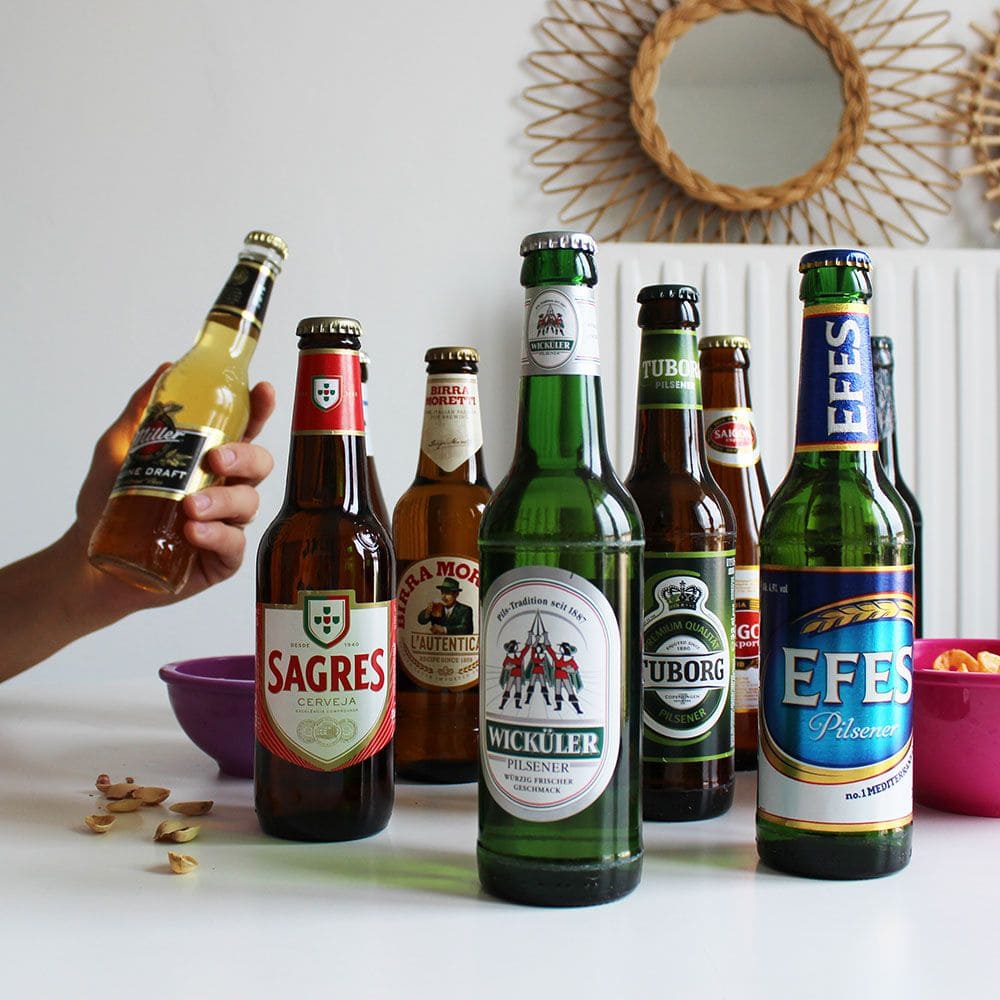
What is a Standard Drink?
A standard drink is a unit of measurement used to quantify the amount of alcohol in a beverage. In the United States, a standard drink contains approximately 0.6 fluid ounces (14 grams) of pure alcohol.
What is a standard drink of beer?
A standard drink of beer typically contains 12 fluid ounces (355 milliliters) and has an alcohol content of around 5% ABV. This is equivalent to approximately 0.6 fluid ounces (14 grams) of pure alcohol.
What is a standard drink of wine?
A standard drink of wine typically contains 5 fluid ounces (148 milliliters) and has an alcohol content of around 12% ABV. This is equivalent to approximately 0.6 fluid ounces (14 grams) of pure alcohol.
What is a standard drink of spirit?
A standard drink of spirits typically contains 1.5 fluid ounces (44 milliliters) and has an alcohol content of around 40% ABV. This is equivalent to approximately 0.6 fluid ounces (14 grams) of pure alcohol
Benefits and Risks of Drinking Beer
Drinking beer can have both benefits and risks, depending on the amount consumed and individual circumstances. Here are some of the potential benefits and risks of drinking beer:
Benefits
- Heart health: Moderate beer consumption (one to two drinks per day) has been linked to a reduced risk of heart disease and stroke.
- Reduced risk of diabetes: Moderate beer consumption has also been linked to a lower risk of developing type 2 diabetes.
- Bone health: Beer contains high levels of silicon, which is beneficial for bone health.
- Social benefits: Drinking beer can be a social activity and can help foster social connections.
Risks
- Addiction: Drinking beer can lead to dependence and addiction, especially with excessive or frequent consumption.
- Increased cancer risk: Drinking beer has been linked to an increased risk of certain types of cancer, including breast, colon, and liver cancer.
- Weight gain: Beer is high in calories and can contribute to weight gain if consumed in excess.
- Liver damage: Excessive or long-term consumption of beer can lead to liver damage and other health problems.
- Impaired judgment: Drinking beer can impair judgment, reaction time, and coordination, which can increase the risk of accidents, injuries, and poor decision-making.
It’s crucial to consume beer in moderation and to be aware of the potential risks and benefits. If you’re concerned about your alcohol intake or have a history of alcohol addiction, it’s important to speak with a healthcare professional.
How Many Beers a Day is Healthy?
There is no definitive answer to how many beers a day is healthy, as it depends on a variety of individual factors, such as age, weight, sex, and overall health.
In general, moderate alcohol consumption is defined as up to one drink per day for women and up to two drinks per day for men, according to the U.S. Dietary Guidelines for Americans.
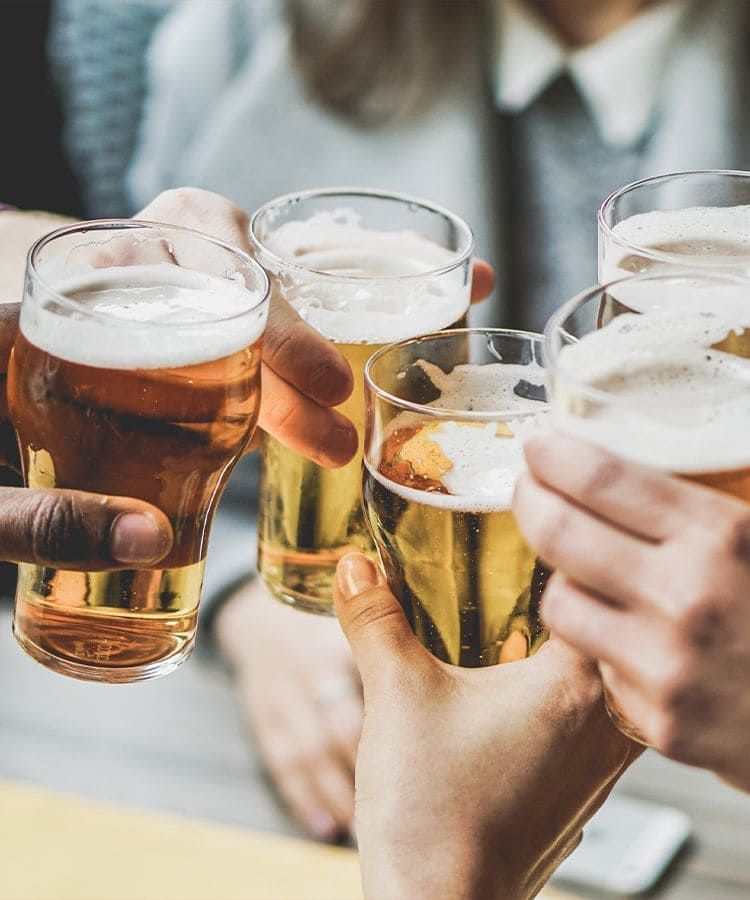
Type of Healthy Beer
While all beers contain varying amounts of nutrients and antioxidants, some types of beer may be considered healthier than others due to their specific ingredients or brewing processes. Here are some types of beer that may be considered relatively healthy:
- Wheat beers: Wheat beers are often brewed with a high percentage of wheat, which contains a range of vitamins and minerals. Additionally, some wheat beers are unfiltered, which can increase their nutrient content.
- Light beers: Light beers typically have lower alcohol content and fewer calories compared to other types of beer, making them a relatively healthy option for moderate drinkers.
- Organic beers: Organic beers are made with organic ingredients and are free from pesticides and other chemicals, making them a healthier and more environmentally friendly option.
- Low-carb beers: Low-carb beers are designed to have fewer carbohydrates than traditional beers, making them a healthier option for people who are watching their carbohydrate intake.
- Hefeweizens: Hefeweizens are a type of wheat beer that is brewed with yeast, which contains high levels of vitamin B and other nutrients.
Which Beer Has the Highest Alcohol Content?
The beer with the highest alcohol content can vary depending on the specific brand and brewing process. However, some of the strongest beers in the world have an alcohol content that is significantly higher than the average beer.
One example of a beer with a high alcohol content is “Snake Venom” by Scottish brewery Brewmeister, which has an alcohol content of 67.5% ABV. Another example is “The End of History” by Scottish brewery BrewDog, which has an alcohol content of 55% ABV.
How Many Beers is Too Many?
The National Institute on Alcohol Abuse and Alcoholism (NIAAA) defines heavy drinking as consuming more than 4 drinks on any day or more than 14 drinks per week for men, and consuming more than 3 drinks on any day or more than 7 drinks per week for women.
How Much Beer to Get Drunk?
The amount of beer needed to get drunk can vary depending on several factors, including body weight, metabolism, and alcohol tolerance.
Typically, it takes about 3-4 beers for the average person to feel tipsy, and around 5-6 beers to become legally intoxicated. However, it’s important to note that individual responses to alcohol can vary greatly.
Some people may feel the effects of alcohol after consuming just one or two beers, while others may need to drink more than six beers to become intoxicated. It’s always a good idea to drink responsibly and be aware of your limits when consuming alcohol.
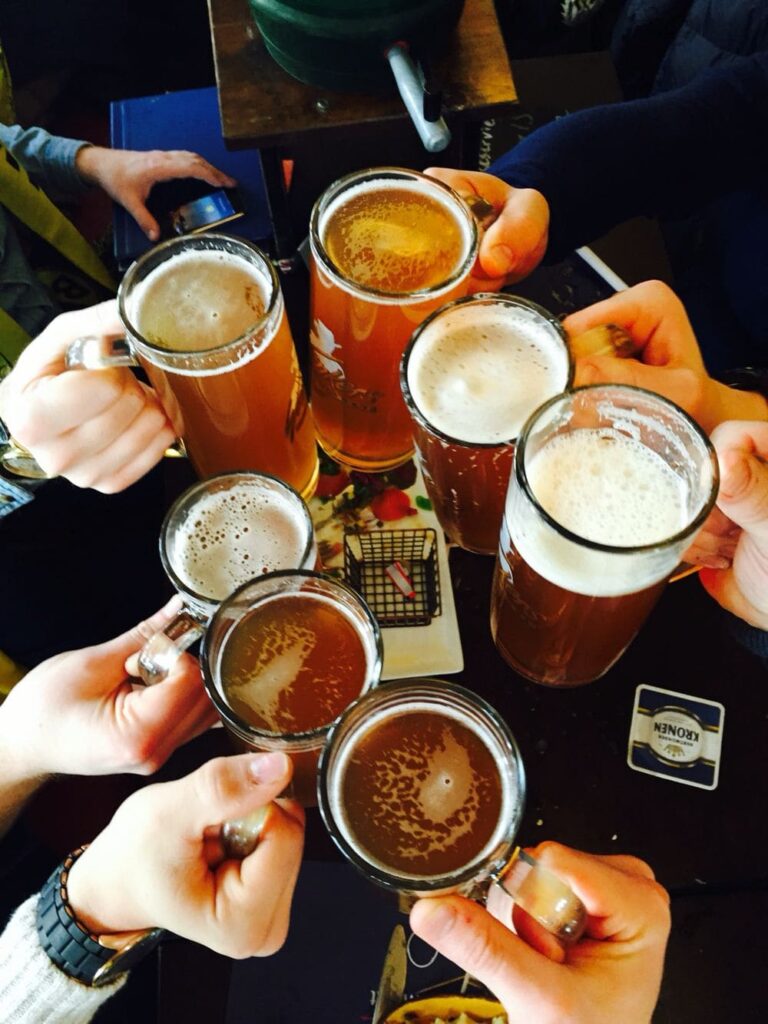
How Does Alcohol Make You Drunk?
Alcohol can make you feel drunk or intoxicated by affecting the way your brain and body function. Here are some ways that alcohol can make you feel drunk:
- Affects the brain: Alcohol affects the brain by increasing the activity of the neurotransmitter GABA, which can slow down brain activity and make you feel relaxed or drowsy. It can also decrease the activity of the neurotransmitter glutamate, which can impair cognitive function and memory.
- Affects the liver: The liver breaks down alcohol in the body, but can only process a certain amount at a time. When you consume more alcohol than your liver can process, the alcohol builds up in your bloodstream, leading to feelings of intoxication.
- Dehydration: Alcohol is a diuretic, which means that it can cause you to urinate more frequently and become dehydrated. Dehydration can lead to symptoms like headaches, dizziness, and fatigue, which can contribute to feelings of drunkenness.
- Impaired motor function: Alcohol can impair motor function by affecting the cerebellum, a part of the brain that controls coordination and balance. This can lead to symptoms like stumbling, slurred speech, and difficulty walking.
- Inhibitions: Alcohol can lower inhibitions by reducing activity in the prefrontal cortex, a part of the brain that is involved in decision-making and impulse control. This can lead to behaviors like reckless driving, aggression, and impaired judgment.
How to Drink Beer Safely
Here are some tips for drinking beer safely:
- Drink in moderation: Consuming beer in moderation means limiting your alcohol intake to one to two drinks per day for women, and up to two drinks per day for men. This can help reduce the risk of negative health effects associated with excessive alcohol consumption.
- Know your limits: Be aware of your tolerance for alcohol and don’t push yourself to drink beyond your limits. If you start feeling the effects of alcohol, slow down or stop drinking.
- Eat food while drinking: Eating food while drinking can help slow the absorption of alcohol into your bloodstream and reduce the risk of getting drunk too quickly.
- Stay hydrated: Drinking plenty of water or non-alcoholic beverages can help prevent dehydration, which can contribute to symptoms of drunkenness.
- Avoid drinking and driving: Drinking and driving is dangerous and illegal. If you plan to drink, make arrangements for a designated driver or use public transportation.
- Avoid mixing alcohol with other drugs: Mixing alcohol with other drugs, including prescription medications, can be dangerous and increase the risk of negative health effects.
- Know when to seek help: If you have concerns about your alcohol consumption or have a history of alcohol addiction, it’s important to speak with a healthcare professional or seek help from a support group or treatment program.
How to Store Beer?
Properly storing beer is important for maintaining its quality and taste. Here are some tips for storing beer:
- Keep beer cool: Beer should be stored at a cool temperature, ideally between 35-45°F (2-7°C). This helps to slow down the aging process and prevent spoilage.
- Store beer upright: Beer should be stored upright to prevent the yeast from settling and potentially affecting the flavor of the beer.
- Keep beer away from light: Beer should be kept away from direct sunlight and other sources of UV light, as this can cause the beer to develop a “skunky” flavor.
- Store beer in a dark place: Beer should be stored in a cool, dark place like a cellar, basement, or refrigerator. If storing in a refrigerator, keep the beer away from the back of the fridge, which can get too cold and freeze the beer.
- Don’t store beer too long: Beer is a perishable product and its flavor can degrade over time. Try to consume beer within a few months of purchase for the best quality and taste.
- Store beer bottles upright: If storing beer in bottles, store them upright to prevent the beer from oxidizing and developing off-flavors.
- Handle beer carefully: Beer should be handled gently and stored in an upright position to prevent shaking and agitation, which can cause the beer to foam excessively.
By following these tips for storing beer, you can help to ensure that your beer stays fresh and tastes great.
FAQs
Are light beers the healthiest choice?
Light beers are generally lower in calories and alcohol content than regular beers, which may make them a healthier choice for some people. However, the specific health benefits and drawbacks of light beers can vary depending on the brand and brewing process. It’s important to consume beer in moderation and to be aware of the alcohol content and nutritional information of any beer you choose to drink.
What percent alcohol is beer 330ml?
The alcohol content of beer can vary widely depending on the specific brand and brewing process. However, on average, a 330ml (11.2 fl oz) beer contains approximately 4-5% alcohol by volume (ABV).
Will 500 ml of beer get me drunk?
Whether 500 ml of beer will get you drunk depends on individual factors such as body weight, sex, and tolerance. In general, consuming 500 ml of beer can contribute to feelings of intoxication, but the actual amount of beer needed to get drunk can vary widely between individuals.
Can 5% alcohol get you drunk?
Whether 5% alcohol can get you drunk depends on individual factors such as body weight, sex, and tolerance. In general, consuming enough 5% alcohol can lead to feelings of intoxication, especially if consumed quickly or in large quantities.
Which beer is good for liver?
While excessive alcohol consumption can be harmful to the liver, some studies have suggested that moderate beer consumption may have a protective effect on liver health. However, there is no one specific beer that is considered “good” for liver health. It’s important to consume beer in moderation and to be aware of the potential risks and benefits of alcohol consumption for your overall health.
Is beer good or bad for heart?
Moderate beer consumption has been linked to a reduced risk of heart disease and stroke in some studies. However, excessive alcohol consumption can have negative effects on heart health, such as high blood pressure and an increased risk of heart disease. It’s important to consume beer in moderation and to speak with a healthcare professional if you have concerns about your alcohol consumption or heart health.
How much does beer cost?
The cost of beer can vary widely depending on the specific brand, location, and other factors. In general, the cost of beer can range from a few dollars per can or bottle to several dollars for a draft beer at a restaurant or bar.
Can you get drunk off Budweiser?
Whether you can get drunk off Budweiser depends on individual factors such as body weight, sex, and tolerance, as well as the amount of Budweiser consumed. Budweiser typically contains around 5% alcohol by volume (ABV), which can contribute to feelings of intoxication if consumed in sufficient quantities.
Can you get drunk off Bud Light?
Bud Light can make you intoxicated depending on body weight, sex, tolerance, and amount ingested. Bud Lite has 4.2% alcohol by volume (ABV), which is lower than some other beers but can still cause drunkenness in large amounts.
Can a 14 year old get drunk off one beer?
Underage drinking in the US is prohibited and dangerous. It’s hard to foresee how one beer will influence a 14-year-old. Avoid underage drinking and get assistance for drinking problems.
Can beer make you gain weight?
Beer can contribute to weight gain if consumed in excess, as it is typically high in calories and carbohydrates. Additionally, alcohol can reduce inhibitions and lead to overeating or making unhealthy food choices. However, moderate beer consumption is not likely to cause significant weight gain, and choosing light beers or consuming beer in moderation can help limit calorie intake.
Can I still enjoy beer if I have a low tolerance for alcohol?
Even with a poor alcohol tolerance, you can enjoy beer. Light beers or beers under 5% ABV are one possibility. Drinking alcohol in moderation and knowing your limitations is also crucial. Consult a doctor if you have alcohol tolerance concerns.
Conclusion
In conclusion, learning about how much alcohol is in beer is an essential aspect of responsible drinking. As someone who enjoys beer, I understand the importance of knowing the alcohol content of the beverage I’m consuming. It’s crucial to be aware of how much alcohol we’re ingesting and to drink in moderation. Knowing the alcohol content of beer can help us manage our alcohol consumption and avoid the negative effects that come with excessive drinking. Therefore, by understanding the science behind the alcohol content of beer and being mindful of our drinking habits, we can enjoy beer while still maintaining a healthy lifestyle.
I’m Chen Mina, from Vol de Nuit, who has a special passion for bartending, especially mixing wine, beer, and cooktail. Here you will find content about alcoholic beverages, I will bring you knowledge that few people know about this drink.

